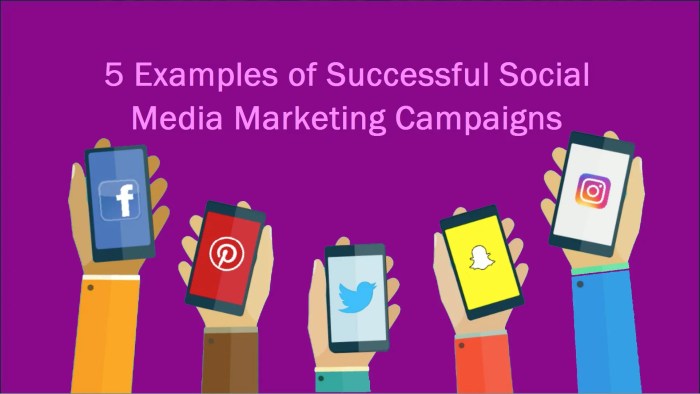Designing Social Media Campaigns dives into the essential aspects of creating impactful campaigns that resonate with audiences and drive business growth. From understanding target audiences to crafting engaging content, this topic explores the key elements needed for a successful social media strategy.
Importance of Social Media Campaigns
In today’s digital age, social media campaigns have become a crucial aspect of marketing strategies for businesses. With the majority of the population actively using social media platforms, designing effective campaigns is essential for reaching and engaging with target audiences.
Well-designed social media campaigns offer numerous benefits for businesses, including increased brand visibility and awareness. By creating engaging and shareable content, businesses can reach a wider audience and attract potential customers. Additionally, social media campaigns allow businesses to interact directly with their audience, fostering a sense of community and loyalty.
One example of a successful social media campaign is the “Share a Coke” campaign by Coca-Cola. By personalizing their products with popular names and encouraging customers to share photos online, Coca-Cola generated a significant amount of user-generated content and increased brand engagement.
Another successful social media campaign is the “Ice Bucket Challenge” for ALS awareness. This campaign went viral on social media, raising millions of dollars for ALS research and significantly increasing awareness for the cause.
Overall, social media campaigns play a vital role in enhancing brand visibility, engaging with audiences, and driving business growth in today’s digital landscape.
Understanding Target Audience
Knowing the target audience is crucial when designing social media campaigns because it helps businesses create content that resonates with their specific demographic. By understanding who they are targeting, businesses can tailor their messaging, visuals, and overall strategy to effectively reach and engage with their audience.
Importance of Audience Research
- Businesses can conduct audience research through surveys, interviews, and analyzing social media insights.
- By gathering data on their target audience’s preferences, behaviors, and interests, businesses can create more personalized and targeted campaigns.
- Understanding the target audience allows businesses to identify the most effective platforms and channels to reach them.
Role of Demographics, Psychographics, and Behavior
- Demographics: Information such as age, gender, location, and income level can help businesses create content that appeals to specific groups.
- Psychographics: Understanding the values, beliefs, and attitudes of the target audience can guide businesses in crafting messages that resonate with their mindset.
- Behavior: Analyzing the online behavior of the target audience, such as what they like, share, and engage with, can help businesses tailor their campaigns to drive desired actions.
Content Creation and Strategy: Designing Social Media Campaigns

Creating engaging and relevant content is crucial for the success of social media campaigns. It helps in attracting and retaining the attention of the target audience, increasing brand awareness, and driving conversions. Content that resonates with the audience can lead to higher engagement levels, shares, and ultimately, better results for the campaign.
Developing a Content Strategy, Designing Social Media Campaigns
A solid content strategy is essential to ensure that the content created aligns with the goals of the social media campaign. Here are some tips for developing a content strategy:
- Define the campaign objectives and key messages.
- Research the target audience to understand their preferences, interests, and pain points.
- Create a content calendar to plan and organize the content creation process.
- Utilize a mix of content types such as images, videos, infographics, blogs, and user-generated content.
- Monitor and analyze the performance of the content to make data-driven decisions and optimize future content.
Types of Content Formats for Different Platforms
Different social media platforms have varying requirements and best practices when it comes to content formats. Here are some popular content formats that work well on different platforms:
- Instagram: High-quality images, stories, reels, and IGTV videos.
- Facebook: Informative posts, live videos, polls, and events.
- Twitter: Short and engaging tweets, polls, threads, and GIFs.
- LinkedIn: Professional articles, industry insights, company updates, and thought leadership content.
- TikTok: Short, creative, and entertaining videos with music and effects.
Visual Elements and Design
Visual elements play a crucial role in social media campaigns as they are the first thing that catches the audience’s attention. The use of eye-catching graphics, images, videos, and other visual elements can significantly impact audience engagement and increase the likelihood of users interacting with the content.
Role of Visual Elements
- Visual elements help in conveying messages quickly and effectively, especially in a fast-paced social media environment where users tend to scroll through content rapidly.
- They can evoke emotions and create a connection with the audience, making the content more memorable and shareable.
- Visuals break up text-heavy content, making it more visually appealing and easier to digest for the audience.
Effective Visual Design Strategies
- Use high-quality images and videos that are relevant to the brand and the message being conveyed.
- Incorporate branding elements such as logos, colors, and fonts to maintain consistency across different campaigns.
- Create visually consistent templates for social media posts to establish a recognizable visual identity for the brand.
- Utilize engaging graphics, infographics, and animations to capture the audience’s attention and communicate information effectively.
Maintaining Brand Consistency
- Consistency in visual elements helps in building brand recognition and trust among the audience.
- Ensure that visual elements such as colors, fonts, and imagery align with the brand’s overall identity and messaging.
- Regularly review and update visual assets to ensure they reflect any changes in the brand’s positioning or messaging.
Campaign Monitoring and Analytics

In the world of social media campaigns, monitoring and analytics play a crucial role in determining the success and effectiveness of a campaign. By tracking metrics and analyzing data, businesses can gain valuable insights into their audience’s behavior, campaign performance, and overall impact.
Importance of Tracking Metrics
- Tracking metrics allows businesses to measure the performance of their social media campaigns against set goals and objectives.
- It helps in identifying which strategies are working and which ones need improvement, enabling businesses to optimize their campaigns for better results.
- Monitoring metrics in real-time provides businesses with the opportunity to make timely adjustments and optimizations during the campaign period.
Key Performance Indicators (KPIs)
- Engagement rate: measuring likes, comments, shares, and overall interaction with the content.
- Reach and impressions: assessing how many people have seen the content and how far it has spread.
- Click-through rate (CTR): evaluating the effectiveness of call-to-action buttons and links.
- Conversion rate: tracking the percentage of users who take the desired action after engaging with the campaign.
Using Analytics for Optimization
- By analyzing data, businesses can identify trends, patterns, and areas of improvement in their campaigns.
- Real-time analytics allow for quick adjustments based on performance data, ensuring the campaign stays on track towards its goals.
- Businesses can use A/B testing to experiment with different content, visuals, or strategies and determine what resonates best with their target audience.












